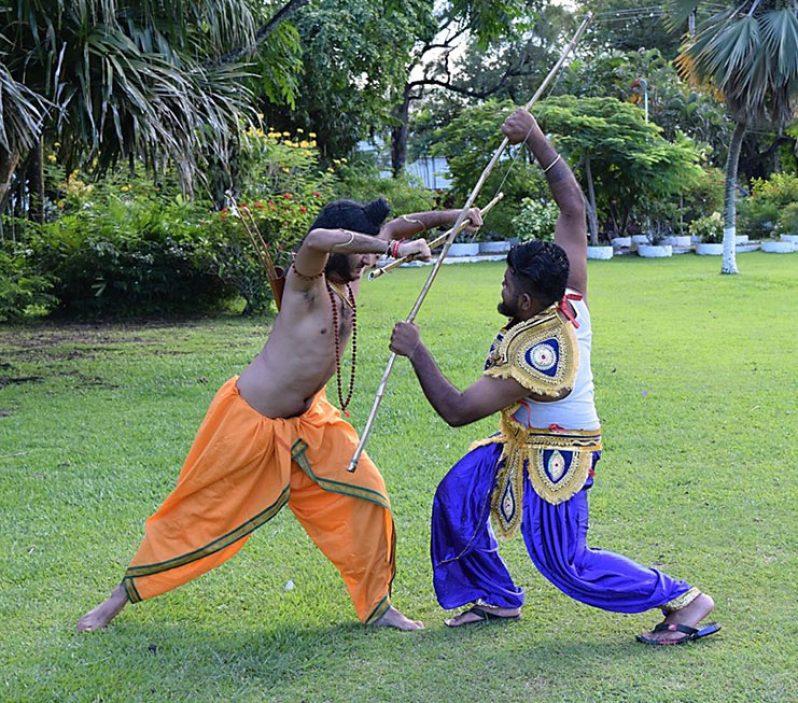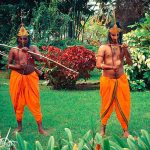Young Guyanese reviving traditional Hindu art form in Guyana
By Ravena Gildharie
HUNDREDS of Guyanese were left mesmerised after this year’s grand showing of the traditional Hindu artform, Ramleela, which was staged during separate displays on October 13, 14 and 15, 2017 at the Lusignan Gopaal Mandir, Lusignan Golf Ground Road, East Coast Demerara.
Each night saw a different gathering of patrons who were eager to witness the rich cultural display leading up to Diwali observances on October 18. Young children especially were enchanted by the talented performances, which depicted religious and cultural stories based on the Hindu scripture in a fun, interactive and creative form.
The shows were organised by the Guyana Ramleela Sangh, a group comprising over 40 young Guyanese including professionals and students attending local university and secondary schools, and who are all focused on revitalising the Ramleela tradition in Guyana. Though the festivities were staged last year, this is the first time it was held on such a large scale with months of ardent planning, preparation and grand performances.
Ramleela or Ramlila conceptualises any dramatic folk re-enactment of the life of Rama according to the ancient Hindu epic Ramayana or secondary literature based on it such as the Ramcharitmanas. The dramatic displays were once very prevalent across Guyana’s Hindu community, as well as those in the Caribbean, but the tradition lost some momentum over time. In 2008, UNESCO declared the Ramlila festivities as an “Intangible Cultural Heritage of Humanity.”
The Guyana Ramleela Sangh was formed in 2013 and members subsequently received training out of Trinidad and India to revive the Hindu artform here.
The group’s Public Relations Officer, Aditya Persaud, explained that the festival is both a religious and cultural event that seeks to promote unity among the Guyanese society. This year, the festival was celebrated prior to Diwali and presented in a “makeshift open-air theatre at nights.”
It included singers and musicians, men and women, elderly and youth who played different parts, sang verses to music, and recited dialogues. The recitations and the narrative of the play were mostly based on Ramacharitamanas, while the dialogue was improvised and responsive to audience reactions.
AUDIENCE INVOLVEMENT
“A Ramlila is not a simple play acted out in a drama theatre, but it is structured to encourage and allow the audience to participate,” Persaud explained, adding: “in major productions, the audience walk with the actors from one site to another, they chant or co-recite passages, they immerse themselves as minor or significant characters in the play, while the major roles are played by a troupe of artists.”
He continued: “the audience cheers when the good gets the upper hand, they are sorrowful when a wrong happens, such as the kidnapping of Sita and her imprisonment against her will by the demon Ravana. They participate in the burning of the effigies, and the community welcomes the return of Rama back to Ayodhya. It is theologically an immersion experience.”
The group started active preparations for the shows over one month ago and had to do a lot of work designing their costumes, building the necessary stage props while readying their minds and bodies for each performance. Rehearsals took place regularly during 19:00 hrs to 23:00 hrs.
Like a family, the young members combined their efforts and talents to continue Ramleela.
“Together, due to the efforts and the love for the story of Rama, we have become so motivated and surely, we will carry on this tradition for as long as we can and will welcome youths with open arms to be a part of our team,” Persaud said.
“This, by itself, is a discipline and provides excellent moral and ethical values for an individual and make them connect with their history and Dharma,” he added.
Ramleela is based on the story of the Hindu God, Rama, from his birth and includes recitals of his childhood, as well as others who played major characters such as Sita, Lakshmana and Ravana. The story includes chapters with the marriage of Sita and Rama, the exile of Rama because Dharma requires him to give up his throne, Sita and Lakshmana joining him in the exile, and their journeys through India.
There are highlights of them meeting revered Rishis of Hinduism; the abduction of Sita by demon Ravana; the sorrow of Rama and Lakshmana; their hopelessness; how they creatively built an army from other living beings in the forest, such as Vanaras (forest men); their journey to Lanka to confront Ravana; the battle between the good and evil; the destruction of Ravana; the return of Rama to Ayodhya as King and the life thereafter.



.jpg)











